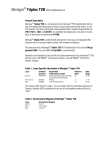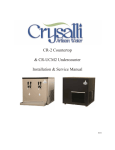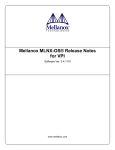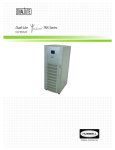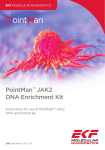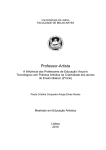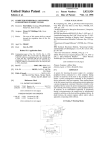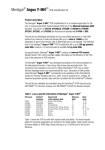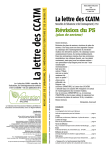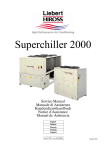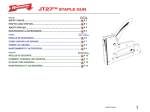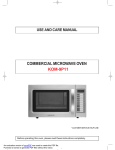Download Animaltype Pig PCR Amplification Kit
Transcript
Animaltype Pig PCR Amplification Kit Features and Benefits Animaltype Pig is the sole commercially available test kit for fast and reliable genotyping of pigs. It includes eleven tetranucleotide markers (see table 1). For the most important breeding stocks German Large White (LW), German Landrace (GL), and “Piétrain” (Pi) the combined Power of Exclusion (cPE) of these STR-Systems is equivalent or even better then the 15 dinucleotide STRs recommended for Germany or Austria (see table 2). Table 1. Animaltype Pig Tetranucleotide STR Markers Locus* 387A12F S0655 SBH1 SBH2 SBH4 SBH10 SBH13 SBH18 SBH19 SBH20 SBH22 SBH23 Chromosomal Mapping 12p14-15 7p11 1p13 3p16-17 6q35 9p11-13 13q46-47 16q23 17q12-14 18q13-23 Xp24 X, Y (gonosomal) * Manuscripts for publication of Loci SBH1-23 in preparation; for 387A12F see Kiuchi et al. (2002); for S0655 see Renard et al. (2001) Table 2. Combined Power of Exclusion of STR Markers German Large White (LW), German Landrace (GL), and “Piétrain” (Pi) Multiplex 11-4- STRs Biotype 15-2- STRs* cPE total 0,9992 0,9965 cPE GL 0,9997 0,9965 cPE LW 0,9987 0,9988 cPE Pi 0,9998 0,9978 * Nechtelberger et al. (2001) Animaltype Pig offers basically and essentially technical advantages: Genotyping of tetranucleotide marker with the Animaltype Pig PCR Amplification Kit guaranties definite peaks (see Fig.1). Moreover, the test kit includes primers for amplification of the gender-specific marker Amelogenin (SBH23). Finally, Animaltype Pig is provided with an Allelic Ladder that allows standardisation of different laboratories. 2 fragment size [bp] Fig. 1 The electropherogram displays the advantages of tetranucleotide-STRs in comparison to dinucleotide STRs. A: S0005 (Dinucleotide STR); B: SBH13 (Tetranucleotide STR); C: SBH7 (Tetranucleotide STR with 2-bp insertion; not included in the test kit). RFU: relative fluorescence units Product Description Animaltype Pig PCR Amplification Kit is a multiplex-application for kinship testing and determination of the gender. In one PCR reaction, the eleven polymorphic tetranucleotide Short Tandem Repeats loci 387A12F, S0655, SBH1, SBH2, SBH4, SBH10, SBH13, SBH18, SBH19, SBH20, and SBH22 as well as the gender-specific marker SBH23 are amplified simultaneously. Preferentially, the test kit is employed for fast and reliable DNA genotyping of blood or tissue samples (especially ear cartilage). One primer for each locus is fluorescencelabelled with 6-FAM (SBH2, SBH18, SBH4, S0655), HEX (SBH23, SBH20, SBH1, SBH10) or NED (SBH13, 387A12F, SBH22, SBH19) whereas a well-balanced intensity of all signals was elaborated for the primer mix. The detection limit of Animaltype Pig PCR Amplification Kit is less about 1 ng genomic DNA. The use of 1-10 ng DNA is recommended. Validation and evaluation of the test kit have been performed for the GeneAmp® 9700 thermal cycler, ABI PRISM® 310 Genetic Analyzer, and ABI PRISM® 3100/3130 Genetic Analyzer. Animaltype Pig December 2007 3 Application - Proof of origin according to the EU-Directive - Kinship testing in context with control of breeding - Status of inbreeding for herd book populations Table 3. Locus-specific Information of Animaltype Pig 387A12F S0655 SBH1 SBH2 SBH4 GenBank® Accession AB059041 AJ251829 submitted submitted submitted SBH10 submitted SBH13 SBH18 SBH19 SBH20 submitted submitted submitted submitted SBH22 SBH23 Y SBH23 X submitted submitted submitted Locus Repeat Motif of the Reference Allele [TTCT]2 CT [TTCT]19 [GGAA]12 [CTTT]13 [AGAA]24 AA [AGAA] [GAAA]2 GGAA [GAAA]2 A [GAAG]7 [GAAA] [GAAG] [AAAG] [AGAG]5 [AAAG]6 AA [AAAG]4 A [AAAG]3 AA [AAAG]4 A [AAAG]21 AG [AAAG]3 AGAG [AAAG]2 [TAGA]15 [CAGA]12 [TAGA]7 TACA [TAGA] TACA [TAGA] TACA [TAGA]2 TACA [TAGA]2 TACA [TAGA]2 CAAA [TATC]15 [AGGA]15 [GTCT]4 [ATCT]10 [CTTT]14 CTTC [CTTT]2 CTTC [CTTT]2 CTTC [CTTT]3 [ATAG]6 ATG [ATAG]11 ATG [ATAG]3 - Reference Allele 21 12 13 25 64 Allele Range 9-21 5-22 7-18 6-34 47.3-66.1 48 31-50 15 15 14 24 8-18 9-23 10-16 19-49 20 18-28 The repeat motifs shown in Table 3 are concordant with the International Society for Forensic Genetics (ISFG) guidelines for the use of microsatellite markers (Bär et al., 1997). Animaltype Pig December 2007 4 Content Animaltype Pig PCR Amplification Kit (100 Reactions) Nuclease-free Water Reaction Mix D Primer Mix DNA polymerase Control DNA DL157 DNA Size Standard 550 Allelic Ladder 3.0 mL 500 μL 250 μL 40 μL 10 μL 25 μL 10 μL Ordering Information Animaltype Pig Animaltype Pig Animaltype Pig Animaltype Pig 25 100 400 1000 Reactions Reactions Reactions Reactions Cat. No. Cat. No. Cat. No. Cat. No. 11-12110-0025 11-12110-0100 11-12110-0400 11-12110-1000 Storage Store all components at –20°C and avoid repeated thawing and freezing. Primer Mix and Allelic Ladder must be stored protected from light. The DNA samples and postPCR reagents (Allelic Ladder and DNA Size Standard) should be stored separately from the PCR reagents. The expiry date is indicated on the kit cover. Quality Assurance The content of Biotype® test kits is subjected to an intensive quality assurance of the Biotype Diagnostic GmbH. The quality of test kits is controlled continuously in order to document the unrestricted usability. For questions regarding the quality assurance, please feel free to contact us. Animaltype Pig December 2007 5 Additional Required Reagents In order to use the Biotype® PCR Amplification Kit additional reagents are needed. We strongly recommend the application of the following products: Reagent Hi-Di™ Formamide, 25 mL Matrix Standards (DS-30) for ABI PRISM® 310 Genetic Analyzer and ABI PRISM® 377 DNA Sequencer Matrix Standards (DS-30) for ABI PRISM® 3100/3130 and ABI PRISM® 3700/3730 Qiagen DNeasy® Blood & Tissue Kit, 50 Preparations Supplier Applied Biosystems Order Number 4311320 Applied Biosystems 401546 and 402996 (NED) Applied Biosystems 4345827 Qiagen 69504 Trademarks and Patents ABI PRISM®, GeneScan®, Genotyper®, GeneMapper™ and Applied Biosystems are registered trademarks of Applied Biosystems Inc. 6-FAM, HEX, NED, ROX, POP-4, and Hi-Di are trademarks of Applied Biosystems Inc. GeneAmp® is a registered trademark of Roche Molecular Systems. The PCR is under patent law. Patentees are Hoffmann-La Roche Inc. and F. HoffmannLa Roche (Roche). DyeEx™ and DNeasy® are registered trademarks of Qiagen. Warning and Safety Instructions The PCR Amplification Kit contains the following potentially hazardous chemical: Kit Component Primer Mix, Reaction Mix and Allelic Ladder Chemical sodium azide NaN3 Danger toxic if swallowed, develops toxic gases when it gets in contact with acids For the Material Safety Data Sheet (MSDS) of all Biotype® products, please contact us. For MSDS of additional reagents to be needed, please contact the corresponding manufactures. Animaltype Pig December 2007 6 Content 1. PCR Amplification.......................................................................................... 7 1.1 Master Mix Preparation ........................................................................... 7 1.2 Master Mix Preparation ........................................................................... 8 2. Electrophoresis using the ABI PRISM® 377 DNA Sequencer............................. 9 2.1 Polyacrylamide-Gel (5%).......................................................................... 9 2.2 Sample Preparation................................................................................. 9 2.3 Setting for GeneScan® Software ............................................................ 10 3. Electrophoresis using the ABI PRISM® 310 Genetic Analyzer ......................... 11 3.1 Matrix Generation.................................................................................. 11 3.2 Sample Preparation............................................................................... 14 3.3 Setting for GeneScan® Software ............................................................ 14 3.4 Analysis Parameter ............................................................................... 15 4. Electrophoresis using the ABI PRISM® 3130/3130xl Genetic Analyzer ............ 16 4.1 Spectral Calibration / Matrix Generation.................................................. 16 4.2 Sample Preparation............................................................................... 19 4.3 Setting for GeneMapper™ ID Software .................................................. 19 4.4 Analysis Parameter (Analysis Method) .................................................... 21 5. Analysis...................................................................................................... 22 5.1 Controls................................................................................................ 24 5.2 Fragment Lengths and Alleles................................................................ 24 6. Interpretation of Results............................................................................... 30 Animaltype Pig December 2007 7 Protocols for PCR Amplification, Electrophoresis, and Analysis 1. PCR Amplification 1.1 Master Mix Preparation The table below shows the volumes of all PCR reagents per 25 μL reaction volume including a DNA sample volume of 3.0 μL (template DNA). Determine the number of reactions to be set up, positive control and negative control reactions should be included. Add one or two reactions to this number to compensate the pipetting error. Volume in [μL] Nuclease-free Water Reaction Mix D* Primer Mix Multi Taq2 DNA Polymerase (hot start, 2.5 U/μL) Volume of Master Mix 1 14.1 5.0 2.5 0.4 22.0 Number of PCR-Reactions 10 25 141.0 352.5 50.0 125.0 25.0 62.5 4.0 10.0 220.0 550.0 100 1410.0 500.0 250.0 40.0 2200.0 * contains Mg2+, dNTP Mix, BSA All components should be mixed (vortex) and centrifuged for about 10 s before preparation of the Master Mix. The DNA volume applied to the assay depends on its concentration. An increase of DNA volume to more than 5 μL is not recommended, because potential PCR inhibitors may interfere. Adjust the final reaction volume with Nuclease-free Water to 25 μL. Generally, store DNA templates in Nuclease-free Water or in diluted TE buffer (10 mM Tris HCl, pH 8.0 and 1 mM EDTA), e. g. 0.1x TE buffer. The Primer Mixes are adjusted for balanced peak heights with 30 PCR cycles and 1-10 ng Control DNA DL157 in a reaction volume of 25 μL. If more DNA template is introduced, higher peaks will be expected for small PCR fragments and relatively low peaks for larger fragments. Reduce the amount of template DNA to correct this imbalance. Positive Control For the positive amplification control, dilute the Control DNA DL 157 to 1-10 ng in the appropriate volume. Instead of the template DNA pipette the diluted Control DNA into a reaction tube containing the PCR Master Mix. Negative Control For the negative amplification control, pipette Nuclease-free Water instead of template DNA into a reaction tube containing the PCR Master Mix. Animaltype Pig December 2007 8 1.2 Master Mix Preparation In order to activate the Multi Taq2 DNA Polymerase and to prevent the formation of non-specific amplification products, perform a “hot start“ PCR reaction. Standard Method recommended for all DNA samples Temperature 94°C 94°C 60°C 72°C 70°C 10°C Time 4 min (hot start for Activation of the Multi Taq2 DNA Polymerase) 20 s 30 Cycles 40 s 30 s 60 min ∞ hold Animaltype Pig December 2007 9 2. Electrophoresis using the ABI PRISM® 377 DNA Sequencer For general instructions on instrument setup, matrix generation and application of the GeneScan® analysis Software, please read the ABI PRISM ® 377 DNA Sequencer User’s Manual. Electrophoresis by using the GeneScan® Software is described below. For the combined application of the four fluorescent dyes 6-FAM, HEX, NED, and ROX (also called DS-30) the use of the virtual Filter Set D is allocated. Generally, the Filter Sets A and F are suitable, too. Prior to any analysis of DNA fragment size a matrix with the appropriate four fluorescent dyes has to be generated for the instrument. Appropriate matrix standards can be purchased from Applied Biosystems. 2.1 Polyacrylamide-Gel (5%) Composition Urea 30% Acrylamide / bisacrylamide solution (29:1) 10x TBE buffer Water Filtrate and degas solution 10% Ammonium persulfate TEMED Use glass plates with a spacing of 36 cm Amount/Volume 21.0 g 8.4 mL 6.0 mL 20.0 mL 350 μL 15 μL 2.2 Sample Preparation Composition Hi-Di™ Formamide / Blue Dextran DNA Size Standard 550 (ROX) PCR product (diluted if necessary) or Allelic Ladder - 3 min denaturation at 95°C - cooling at 4°C - apply 1.5 μL sample to the gel Animaltype Pig Volume 1.8 μL 0.2 μL 1.0 μL December 2007 10 2.3 Setting for GeneScan® Software Plate Check Module D PreRun Module "GS PR 36D - 1200" Run Module "GS Run 36D - 1200" Matrix D (6-FAM, HEX, NED, ROX) Standard SST550 (ROX) Programming of the Run Module for Biotype® Test Kits (6-FAM / HEX / NED / ROX) - Open program "377 Collection" - Open File - New - GeneScan Run - Select the module "GS Run 36D -1200" in the run window - Click at the sheet symbol in the run window - Use the following settings: Parameter Voltage Current Power Collection time Gel temperature Laser power Setting 3000 V 50.0 mA 150 W 3.0 h 51°C 40.0 mW Animaltype Pig Save the module in the field „Save Copy“ December 2007 11 3. Electrophoresis using the ABI PRISM® 310 Genetic Analyzer For general instructions on instrument setup, matrix generation and application of the GeneScan® or GeneMapper™ ID Software, please read the ABI PRISM ® 310 Genetic Analyzer User’s Manual. Electrophoresis by using the GeneScan® Software is described below. For the combined application of the four fluorescent labels 6-FAM, HEX, NED, and ROX (also called DS-30) the use of the virtual Filter Set D is allocated. Generally, Filter Sets A and F are suitable, too. Material Capillary Polymer Buffer 47 cm / 50 μm (green) 310 Genetic Analyzer POP-4 10x Genetic Analyzer Buffer with EDTA 3.1 Matrix Generation Prior to any analysis of DNA fragment size a matrix with the appropriate four fluorescent labels has to be generated. Suitable matrix standards can be purchased from Applied Biosystems. Dye Color Blue (B) Green (G) Yellow (Y) Red (R) Matrix Standard 6-FAM HEX NED ROX Order Number Applied Biosystems, 401546 Applied Biosystems, 401546 Applied Biosystems, 402996 Applied Biosystems, 401546 To generate useful matrix files, it is necessary to perform four electrophoresis runs with the matrix samples (PCR fragments labelled with 6-FAM, HEX, NED and ROX). The runs have to be done under the same conditions like for the samples and the Allelic Ladders of the Biotype® test kit. Matrix sample Composition Hi-Di™ Formamide Matrix Standard 6-FAM Volume 12.5 μL 1.0 μL Matrix sample 2 Hi-Di™ Formamide Matrix Standard HEX 12.5 μL 1.0 μL Matrix sample 3 Hi-Di™ Formamide Matrix Standard NED 12.5 μL 1.0 μL Matrix sample 4 Hi-Di™ Formamide Matrix Standard ROX 12.5 μL 1.0 μL Matrix sample 1 - 3 min denaturation at 95°C - cooling at 4°C - for analysis: load the samples on the tray - Create a Sample Sheet and enter sample designation Animaltype Pig December 2007 12 Injection List for Matrix Generation Injection list Module File GS STR POP-4 (1 mL) D Matrix File NONE Size Standard* NONE Injection [s] 5 Injection [kV] 15.0 Run [kV] 15.0 Run [°C] 60 Run Time [min] 24 * prepare Matrix Standards always without DNA Size Standard (ROX) Analysis of the Matrix Samples - Open GeneScan® or GeneMapper™ ID Software - FILE → NEW → PROJECT (open current run folder) → ADD SAMPLE FILES - Click a single matrix sample in the column SAMPLE FILE - Mark SAMPLE → RAW DATA - Review the matrix samples for a flat baseline beyond the primer peak. There should be at least five peaks with peak heights about 400-4000 (Y) in every matrix sample (optimal range: 1000-3000), as shown in Fig. 2 ▼ 3400 Data Points (X) 6400▼ Fig. 2 Electropherogram with Raw Data of the Matrix Standard 6-FAM - Select analysis range with flat baseline - Re-inject the matrix sample if necessary - Note start and end value (Data Points) of the analysis range, e. g. start value 3400, end value 6400 - Calculate the difference value, e. g. 6400-3400 = 3000 Data Points Animaltype Pig December 2007 13 Generation of a New Matrix - FILE → NEW → MATRIX, as shown in Fig. 3 Fig. 3 Select Matrix Samples - Import matrix samples for all dyes (B, G, Y, R) - Enter „Start At“ value, e. g. 3400 - Enter difference value at Points, e. g. 3000 - Select OK to calculate the new matrix, as shown in Fig. 4 Fig. 4 New Matrix Biotype - Save in the Matrix Folder: FILE → SAVE AS, e. g. Matrix Biotype Matrix Check Please check the new matrix with current samples. - FILE → NEW → PROJECT (open run folder) → ADD SAMPLE FILES - Select sample(s) in the column SAMPLE FILE - SAMPLE → INSTALL NEW MATRIX (open matrix folder and select new matrix) - Re-Analyse your samples With the new matrix there should be no pull-up peaks between the dye panels (B, G, Y, R). Animaltype Pig December 2007 14 3.2 Sample Preparation Composition Hi-Di™ Formamide DNA Size Standard 550 (ROX) prepare 12 μL of the mix (Formamide + DNA Size Standard) for all samples add 1 μL PCR product (diluted if necessary) or Allelic Ladder - 3 min denaturation at 95°C - cooling at 4°C - for analysis: load the samples on the tray Volume 12.3 μL 0.2 μL Signal Intensities In order to increase the intensity of signals: - Reduce the volume of the DNA Size Standard 550 (ROX); the peaks of the Size Standard should be about 500 relative fluorescent units (RFU) - Purify the PCR products with DyeEx™ 2.0 Spin Kit, Qiagen (63204) 3.3 Setting for GeneScan® Software - Create a Sample Sheet and enter sample designation Injection List Module File Matrix File Size Standard Injection [s]* Injection [kV] Run [kV] Run [°C] Run Time [min]** GS STR POP-4 (1 mL) D z. B. Matrix Biotype z. B. SST550_50-500bp 5 15.0 15.0 60 28 * Apart from standard setting, the injection time may be between 1 and 10 s depending on the type of sample. If blood samples with very high signal intensities are to be recorded, a shorter injection time may be selected. For samples with low DNA content an injection time up to 10 s may be necessary. ** Depending on the analysis conditions, the Run Time for Animaltype Pig was modified in order to analyze lengths of fragments up to 500 bp. Animaltype Pig December 2007 15 3.4 Analysis Parameter The recommended analysis parameters are: Analysis Range Start: 2000 Stop: 10000 Baseline: Checked Multicomponent: Checked Smooth Options: Light Peak Amplitude Thresholds B:* Y:* G:* R:* Min. Peak Half Width: 2 pts Polynorminal Degree: 3 Peak Window Size: 11 pts** Min: 50 Max: 550 Local Southern Method None Data Processing Peak Detection Size Call Range Size Calling Method Split Peak Correction * The peak amplitude threshold (Cutoff value) corresponds to the minimum peak height that will be detected from the GeneScan® or GeneMapper™ ID Software. Thresholds are usually 50-200 RFU and should be determined individually by the laboratory. Recommendation: The minimal peak height should be three times higher then the background noise of the baseline. ** Sometimes, point alleles (i. e. alleles with at least 1 bp difference to the next integer allele) like 387A12F allele 13 and 13.1 or 16 and 16.1 can not be distinguished. For improved peak detection, minimize the Peak Window Size further on. Animaltype Pig December 2007 16 4. Electrophoresis using the ABI PRISM® 3130/3130xl Genetic Analyzer For detailed instructions on instrument setup, spectral calibration, or application of the ABI PRISM® Data Collection Software and the GeneMapper™ ID Software, refer to the ABI PRISM ® 3130/3130xl Genetic Analyzers Getting Started Guide. Electrophoresis by using the GeneMapper™ ID Software is described below. The 4-Capillary-System is named ABI 3130 (before ABI 3100-Avant), the 16-CapillarySystem is named ABI 3130xl (before ABI 3100). For the combined application of the four fluorescent labels 6-FAM, HEX, NED, and ROX (also called DS-30) the utilization of the Dye Set D is allocated. Material Capillary Polymer Buffer 3130 capillary array, 36 cm 3130 POP-4 polymer 10x Genetic Analyzer Buffer with EDTA 4.1 Spectral Calibration / Matrix Generation Prior to any analysis of DNA fragment size a spectral calibration with the four florescent labels 6-FAM, HEX, NED and ROX has to be generated for each analyzer. The spectral calibration creates a matrix to correct the overlapping of fluorescence emission spectra of the dyes. Performing a spectral calibration can be divided into the following tasks: - Choosing and setting up the Spectral Calibration Standards - Loading the standards on the 96-well reaction plate (per capillary one sample) - Creating the instrument protocol for performing spectral calibration (Protocol Manager) - Define the plate assembly within the plate editor (Plate Manager) - Performing a spectral calibration run and reviewing data Animaltype Pig December 2007 17 Setting up the Spectral Calibration Standards Example for 4 Capillaries/ABI 3130 Composition Volume Hi-Di™ Formamide 47.5 μL Matrix Standard 2.5 μL - 3 min denaturation at 95°C - cooling at 4°C - for analysis, load 10 μL of the Matrix Standard into a 96-well reaction plate, well A1-D1 Example for 16 Capillaries/ABI 3130xl Composition Volume Hi-Di™ Formamide 190 μL Matrix Standard 10.0 μL - 3 min denaturation at 95°C - cooling at 4°C - for analysis, load 10 μL of the Matrix Standard into a 96-well reaction plate, well A1-H1 and A2-H2 Performing Spectral Calibration Run - Insert the 96-well plate on the autosampler tray - In the Protocol Manager of the Data Collection Software click New in the window Instrument Protocol to open the Protocol Editor dialog box Instrument Protocol for Spectral Calibration Protocol Editor Name Type Dye Set Polymer Array Length Chemistry Run Module e. g. Spectral36_POP4_DS30 SPECTRAL D POP4 36 Matrix Standard Spect36_POP4_1 - Select OK to complete the Protocol Editor dialog box Animaltype Pig December 2007 18 - In the Plate Manager of the Data Collection Software click New to open the New Plate Dialog box Plate Editor for Spectral Calibration (I) New Plate Dialog Name Application Plate Type Owner Name / Operator Name e. g. Spectral_DyeSet D_Date Spectral Calibration 96-Well … - Select OK to complete the New Plate dialog box. A new table in the Plate Editor opens automatically - For further analyses for spectral calibration use with the same plate setting, click Import, select the .xml file and click Open Plate Editor for Spectral Calibration (II) Column Sample Name Priority Instrument Protocol 1 Type name for the matrix samples e. g. 100 Spectral36_POP4_DS30 (setting described before) - For each of the columns, click the column header to select entire column, then select Edit → Fill Down to apply the information to all of the selected samples, and enter OK - In Run Scheduler click Find All, select link to link up the reaction plate on the autosampler with the newly created plate record (position A or B) and start the run - View Pass/Fail Status after the run in the Event Log and open the Spectral Viewer to review and evaluate the spectral calibration profile for each capillary Fig. 5 Electropherogram with Raw Data of the Matrix Standard for DS-30 Note: If all capillaries passed the test, activate this Spectral Calibration file for Dye Set D in the Spectral Viewer. Animaltype Pig December 2007 19 4.2 Sample Preparation Composition Hi-Di™ Formamide DNA Size Standard 550 (ROX) prepare 12 μL of the mix (Formamide + DNA Size Standard) for all samples add 1 μL PCR product (diluted if necessary) or Allelic Ladder - 3 min denaturation at 95°C - cooling at 4°C - for analysis: load the samples on the tray Volume 12.3 μL 0.2 μL Because injections proceed simultaneously for all capillaries, four samples must be pipette for analysis on 4-capillary analysers. If less then four samples are analysed, fill up the empty positions on the plate with 12 μL Hi-Di™ Formamide. For reliable allelic assignment on 4-capillary analysers, one Allelic Ladder per capillary should be run. Room temperature may influence the performance of PCR products on multi-capillary instruments, so that shoulder peaks or split peaks occur especially at low temperatures. Pay attention to keeping ambient conditions as recommended by the instrument manufacturer. 4.3 Setting for GeneMapper™ ID Software Performing Run - Insert the 96-well plate prepare on the autosampler tray - In the Protocol Manager of the Data Collection Software click New in the window Instrument Protocol to open the Protocol Editor dialog box Instrument Protocol Protocol Editor Name Type Run Module* Dye Set Run36_POP4_DyeSet D REGULAR HIDFragmentAnalysis36_POP4_1 D * for detailed description see Setting of the Run Module on the next page - Select OK to complete the Protocol Editor dialog box Animaltype Pig December 2007 20 Previous to the first run, it is necessary to edit the Run Module as follows: - In the Module Manager of the Data Collection Software click New to open the Run Module Editor dialog box Run Module (24min_50-500bp) Run Modul Editor Oven Temperature [°C] Poly Fill Volume Current Stability [μA] PreRun Voltage [kV] PreRun Time [s] Injection Voltage [kV] Injection Time [s]* Voltage Number of Steps Voltage Step Interval Data Delay Time [s] Run Voltage [kV] Run Time [s]** Value 60 4840 5 15 180 3.0 5 40 15 1 15.0 1440 * Apart from standard settings, the injection time may range between 1 and 20 s depending on the type of sample. If samples with very high signal intensities are to be recorded, a shorter injection time may be selected. For samples with low DNA content an injection time up to 20 s may be necessary. ** Depending on the analysis conditions, the Run Time for Animaltype Pig was modified in order to analyze lengths of fragments up to 500 bp. - Click Save As and enter the name of the new module (e. g. 24min_50-500bp) and enter OK - Click Close to exit the Module Editor Previous to every run, it is necessary to compile the plate as follows: - In the Plate Manager of the Data Collection Software click New to open the New Plate Dialog box GeneMapper™ Plate Editor (I) New Plate Dialog Name Application Plate Type Owner Name / Operator Name e. g. Plate_DyeSet D_Date select GeneMapper Application 96-Well … - Select OK to complete the New Plate dialog box. A new table in the Plate Editor opens automatically Animaltype Pig December 2007 21 GeneMapper™ Plate Editor (II) Column Name Sample Name Priority Sample Type Size Standard Panel Analysis Method Snp Set User-defined 1-3 Results Group 1 Instrument Protocol 1 Type name for the samples e. g. 100 (Default) Sample or Allelic Ladder e. g. SST550_50-500bp e. g. Animaltype_Panels_v1 e. g. Analysis_HID_3130 (select results group) Run36_POP4_DyeSet D (setting typed before) - For each of the columns, click the column header to select entire column, then select Edit → Fill Down to apply the information to all of the selected samples and enter OK - In Run Scheduler click Find All, select link to link up the reaction plate on the autosampler with the newly created plate record (position A or B) and start the run - During the run, view Error Status in the Event Log or examine the quality of the raw data for each capillary in the Capillaries Viewer or the Cap/Array Viewer - View data as overview in Run History or Cap/Array Viewer of the Data Collection Software. Run data are saved in the Run Folder of the former chosen Result Group 4.4 Analysis Parameter (Analysis Method) The recommended settings in the worksheet Peak Detector are: Peak Detection Algorithm Ranges Smoothing and Baselining Size Calling Method Peak Detection Advanced Analysis: Partial Range Start Pt: 2000; Stop Pt: 10000 Sizing: All Sizes Smoothing: Light Baseline Window: 51 pts Local Southern Method Peak Amplitude Thresholds B:* Y:* G:* R:* Min. Peak Half Width: 2 pts Polynominal Degree: 3 Peak Window Size: 11 pts** Slope Thresholds: 0.0 * The peak amplitude threshold (Cutoff value) corresponds to the minimum peak height that will be detected from the GeneMapper™ ID Software. The thresholds are usually 50-200 RFU and should be determined individually by the laboratory. Recommendation: The minimal peak height should be three times higher then the background noise of the baseline. ** Sometimes, point alleles (i. e. alleles with at least 1 bp difference to the next integer allele) like 387A12F allele 13 and 13.1 or 16 and 16.1 can not be distinguished. For improved peak detection, minimize the Peak Window Size further on. Animaltype Pig December 2007 22 5. Analysis For general instructions on automatic sample analysing, please read the GeneScan® or GeneMapper™ ID Software User’s Manual. The determination of the exact lengths of the amplified products depends on the type of device, on the conditions of electrophoresis, as well as on the DNA Size Standard used. Due to the complexity of some STR loci, the size determination should be based on evenly distributed points of references. Thus, please use the DNA Size Standard 550 (ROX) with the following lengths of fragments: 50, 60, 70, 80, 90, 100, 120, 140, 160, 180, 190, 200, 220, 240, 260, 280, 300, 320, 340, 360, 380, 400, 425, 450, 475, 500, 525 and 550 bp. Fig. 6 Electropherogram of the DNA Size Standard 550 (ROX), Lengths of Fragments in bp Allele designation of analyzed samples should be carried out either manually or with suitable analysis software, e. g. GeneMapper™ ID or Genotyper® Software in combination with the Animaltype Pig Template File from Biotype. Template Files can be received as free downloads from our homepage (www.biotype.de) or as CD-ROM on request. Animaltype Pig December 2007 23 Special Features SBH4 In rare cases deviation of 0.6 bp between signals versus the Allelic Ladder due to single nucleotide polymorphisms (SNPs) within repeating units can be observed. Exact assignment of all alleles according to the Allelic Ladder is achieved by setting the tolerance to +/- 1.0 bp in the analysis software. This point is already fixed in Biotype® Template Files for Genotyper® or GeneMapper™. SBH1 Sometimes deviation of the signals for allele 14 and 15 versus the Allelic Ladder due to SNPs within repeating units can be observed. Exact assignment of these alleles according to the Allelic Ladder is achieved by setting the tolerance to +/- 2.0 bp in the analysis software. This point is already fixed in Biotype® Template Files for Genotyper® or GeneMapper™. SBH23 (Amelogenin) Rarly, deviation of + 1.0 bp for the X-specific signal versus the Allelic Ladder due to an insertion of a base can be observed. Exact assignment of the X-specific allele according to the Allelic Ladder is achieved by setting the tolerance to +/- 2.0 bp in the analysis software. This point is already fixed in Biotype® Template Files for Genotyper® or GeneMapper™. Unspecific amplificates Two artefact signals were observed in 6% of the DNA samples from Biotype Diagnostic GmbH at position 294 bp in 6-FAM between the allelic ranges of SBH18 and SBH4 and at position 298 bp in HEX within the allelic region of SBH1. These artefacts do not match with signals of the Allelic Ladder or with known alleles from the population study. Animaltype Pig December 2007 24 5.1 Controls The Control DNA DL157 of the PCR Amplification Kit represents the following alleles: Table 4. Allele Determinations of Animaltype Pig Locus 387A12F S0655 SBH1 SBH2 SBH4 SBH10 SBH13 SBH18 SBH19 SBH20 SBH22 SBH23 Control DNA DL157 13/21 9/12 14/16 22/33 56/62 48/49 13/15 12/14 14/14 32/39 20/23 Y/X 5.2 Fragment Lengths and Alleles Table 5 to table 7 display the values for fragment lengths of individual alleles that refer to the DNA Size Standard 550 (ROX). All analyses have been performed on an ABI PRISM® 310 Genetic Analyzer with POP-4 polymer. Different analysis instruments, DNA Size Standards or polymers might result in different lengths of fragment. These Data could serve as approximate allele sizes for the creation of a new analysis template. In order to balance instrument-specific deviations further fine tuning of the equipment should be done by measuring sample fragments of known lengths. In addition, a visual alignment with the Allelic Ladder is recommended. Scaling Horizontal: 75-505 bp Vertical: Depending on signal intensity Animaltype Pig December 2007 - 25 - DNA Size Standard 550 (ROX) SBH22 387A12F SBH20 SBH23 SBH13 SBH2 SBH18 SBH1 SBH4 SBH19 SBH10 SO655 Figure 7 Fig. 7 Electropherogram of the Animaltype Pig using 2 ng Control DNA DL157. Analysis was done on an ABI PRISM® 310 Genetic Analyzer with the DNA Size Standard 550 (ROX). Allele assignment was performed using the Genotyper® Software and the Animaltype Pig Template File. Animaltype Pig September 2006 26 Figure 8 Fig. 8 Electropherogram of the Animaltype Pig Allelic Ladder analysed on an ABI PRISM® 310 Genetic Analyzer. Allele assignment was performed using the Genotyper® Software and the Animaltype Pig Template File. Animaltype Pig December 2007 27 Table 5. Fragment Lengths of the Allelic Ladder Animaltype Pig analysed on an ABI PRISM® 310 Genetic Analyzer (Blue Panel) Allele Size [bp] Further Alleles* ABI 310 Allele Size [bp] ABI 310 SBH2 6-FAM SBH4 6-FAM 6 84.0 47.3 317.4 322.7 21 22 24 25 139.2 143.2 49.1 a 23 151.0 50.1 51.3 154.9 53 327.3 332.6 337.2 Allele Size [bp] Further Alleles* ABI 310 S0655 6-FAM ±1.0 bpb 5 416.6 ±1.0 bp b 6 420.6 ±1.0 bp b 7 424.7 ±1.0 bp b 9 432.5 ±1.0 bp b 10 436.8 b 11 440.8 Remarks 26 158.9 54 341.5 ±1.0 bp 27 163.0 55.1 347.6 ±1.0 bpb 12 445.2 349.1 ±1.0 bp b 13 449.4 ±1.0 bp b 14 453.8 ±1.0 bp b 15 458.1 b 16 462.2 28 29 30 167.1 56 171.3 57 175.5 58 353.0 357.0 31 179.7 59 360.7 ±1.0 bp 32 183.9 60 364.6 ±1.0 bpb 17 466.5 368.4 ±1.0 bp b 18 470.8 ±1.0 bp b 22 487.6 b 33 34 188.0 192.2 61 a 35 62 372.2 64 380.2 ±1.0 bp SBH18 6-FAM 65.1 385.8 ±1.0 bpb 9 214.4 66.1 389.7 ±1.0 bpb 11 222.5 12 226.6 13 230.8 14 235.0 15 239.2 16 243.5 17 247.3 18 251.3 19 255.2 20 259.2 21 263.2 22 267.1 23 271.0 Animaltye Pig December 2007 28 Table 6. Fragment Lengths of the Allelic Ladder Animaltype Pig analysed on an ABI PRISM® 310 Genetic Analyzer (Green Panel) Allele Size [bp] ABI 310 Allele Size [bp] ABI 310 SBH23 HEX SBH1 HEX Y 83.4 7 283.8 X 93.4 9 292.0 10 296.0 Further Alleles* X (94.4)b Further Alleles* 8a SBH20 HEX 11 300.0 19 136.0 12 304.2 20 139.9 13 308.4 21 143.6 14 312.6 ±2.0 bpb 22 147.3 15 316.8 ±2.0 bpb 23 151.1 16 320.9 24 154.8 17 324.9 25 159.7 18 329.1 26 163.6 28 171.2 SBH10 HEX 29 175.5 31 363.5 30 179.5 32 367.5 31 183.5 33 371.5 32 187.5 34 375.7 33 191.6 35 379.9 34 195.6 36 383.9 35 199.4 37 388.0 36 203.3 38 392.0 37 207.3 40 400.0 39 214.8 41 404.0 40 218.6 42 408.0 41 222.6 43 412.0 43 230.6 44 415.8 49 254.1 46 423.8 47 427.8 48 431.8 50 439.8 38a Animaltype Pig 39a 45a 49a December 2007 29 Table 7. Fragment lengths of the Allelic Ladder Animaltype Pig analysed on an ABI PRISM® 310 Genetic Analyzer (yellow panel) Allele Size [bp] ABI 310 Allele Size [bp] ABI 310 SBH13 NED SBH22 NED 8 98.7 18 291.7 9 102.8 19 295.7 10 107.0 20 299.7 11 111.2 22 307.7 12 115.6 23 311.7 13 119.9 23.3 314.7 24a 14 124.2 24.3 318.7 25a, 25.3a 15 128.5 28 332.3 27.3a 16 132.7 17 136.9 SBH19 NED 18 140.9 10 386.5 11 390.7 12 394.7 13 399.0 14 403.0 387A12F NED 9 205.4 Further Alleles* a 10.1 210.3 11 12.1 218.3 15 407.0 13 221.4 16 411.0 13.1 222.4 14.1 226.6 14a 15 229.8 15.1a 16 234.0 16.1 235.0 17 238.2 18 242.2 19.1 247.2 20 250.2 21 254.2 17.1a * a. Biotype (DNA pool), b. see Special Features (chapter 5) Animaltye Pig December 2007 Further Alleles* 30 6. Interpretation of Results As mentioned above, post PCR analysis and automatic allele allocation with suitable analysis software ensure a precise and reliable discrimination of alleles. Pull-up Peaks If peak heights are outside the linear detection range (>3000 RFU) or if an incorrect matrix has applied, pull-up peaks can occur at positions of a specific peaks in all colour channels. In order to avoid pull-up peaks, peak heights should not exceed more than 3000 RFU. Stutter Peaks Appearance of stutter peaks depends on the sequence of the repeat structure and on the number of alleles. n-4 peaks are due to a loss of a repeat unit during amplification of tetranucleotide STR motives caused by slippage effects of the Multi Taq2 DNA Polymerase. Interpretation of those peaks should be done in accordance with the Template Files of the Genotyper® and GeneMapper™ ID Software. Template-independent Nucleotide Addition The terminal transferase activity of Multi Taq2 DNA Polymerase leads to the addition of an adenosine residue preferentially at the 3’-end of amplified DNA fragments. Incomplete extension is responsible for double peaks, resulting from the absence of the terminal adenosine residue. The artefact peak is one base shorter than expected (-1 peaks). All Biotype® primers are designed to minimize these artefacts. In addition, the final extension step of 70°C for 60 minutes is included to the PCR protocol in order to reduce formation of artefacts. Peak height of the artefact correlates with the amount of DNA. Every laboratory should determine their own thresholds for analysis of the peaks. Animaltye Pig December 2007 31 References Bär W, Brinkmann B, Budowle B, Carracedo A, Gill P, Lincoln P, Mayr W, Olaisen B (1997) DNA recommendations. Further report of the DNA Commission of the ISFH regarding the use of short tandem repeat systems. Int. J. Legal Med. 110: 175-176. Kiuchi S, Inage Y, Hiraiwa H, Uenishi H, Yasue H (2002) Assignment of 280 swine genomic inserts including 31 microsatellites from BAC clones to the swine RH map (IMpRH map). Mamm. Genome 13: 80-88. Nechtelberger D, Kaltwasser C, Stur I, Meyer JN, Brem G, Mueller M, Mueller S (2001) DNA microsatellite analysis for parentage control in Austrian pigs. Anim Biotechnol 12: 141-144. Renard C, Vaiman M, Chiannilkulchai N, Cattolico L, Robert C, Chardon P (2001) Sequence of the pig major histocompatibility region containing the classical class I genes. Immunogenetics 53: 490-500. Animaltye Pig December 2007 32 Notes Animaltye Pig December 2007

































